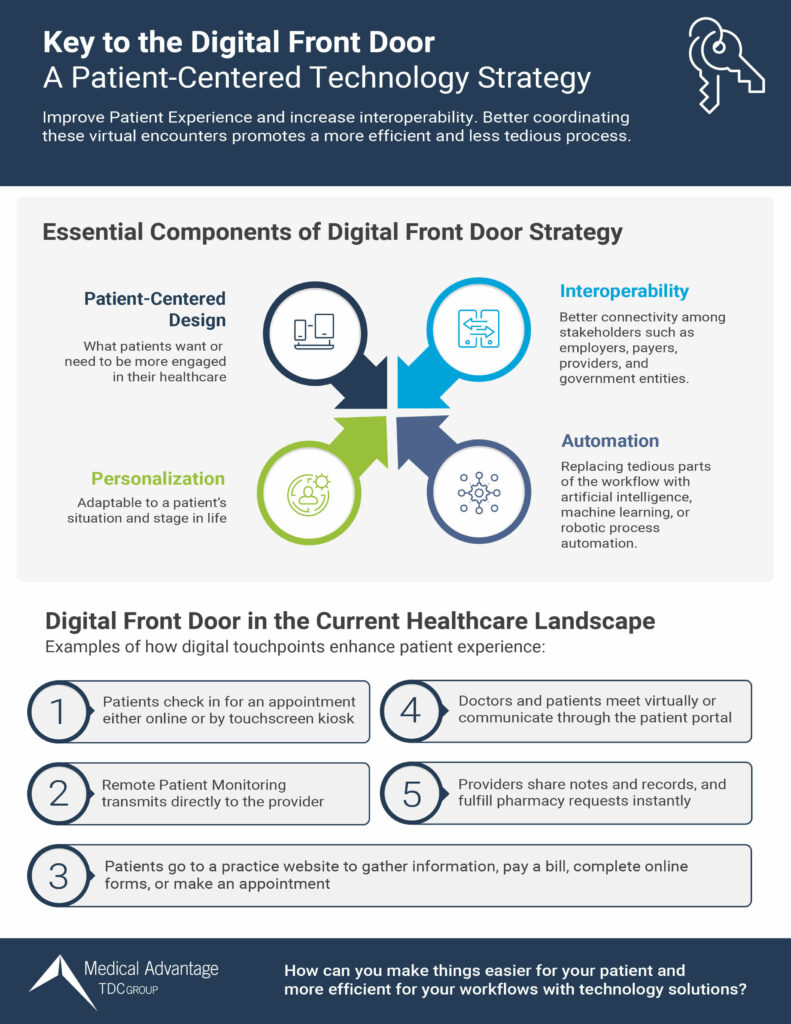Handheld devices connected to the internet at all times allows for flexibility, greater productivity, and speed of service. Though we may not realize it, these interactions with technology all start with a digital front door. During the pandemic lockdowns of 2020, many more medical practices and patients were introduced to the benefits of the digital front door with the help of technology’s continued delivery of care (such as virtual visits).
Leveraging technology to improve healthcare carries with it many rewards, including readiness for a future that continues to be shaped by the consumerization of healthcare where patients have more influence and control. Consumers are already familiar with digital front door experiences as digital marketing evolves, such as online check-in for a flight or paying a restaurant tab at the table, as these industries understand that consumers gravitate toward what is simple and convenient.
Digital front door initiates a necessary conversation about how to go about building a more centralized and interoperable patient experience that benefits all involved and keeps pace with consumer demands and expectations.
What Is Digital Front Door in Healthcare?
Put simply, the digital front door is an entry point for care delivered virtually – a website, patient portal, mobile apps, email engagement, anything that elicits a patient’s participation in the digital space. Through digital front doors, patients access a variety of healthcare helpers that make the patient experience easier and more accessible.
Interacting with a digital front door looks like:
- A patient scheduling an appointment online late at night rather than setting a reminder to call the clinic the next day.
- Finding answers to questions on the practice website rather than calling the clinic and going through the rigamarole of a phone tree.
- Completing forms electronically that can be easily uploaded by the practice into the EHR. (Electronic Health Record) rather than paper forms for data entry.
- A patient making payments online at their own convenience rather than incurring the cost of postage to and from the provider. Both patient and provider save money.
- Online or kiosk check-in to simplify and accelerate the reception process.
- Engaging with the patient portal that gives the patient access to medical records at all times.
- Participating in telehealth, virtual visits, or remote patient monitoring.
- Completing a patient experience survey online.
- Providers sharing notes and records via secure electronic transmission for collaborative care.
While the ultimate goal of the digital front door is to keep the provider connected to the patient, this framework can also involve payers, employers, and point solutions for increased interoperability. Healthcare has yet to create a seamless data-sharing platform, but by centralizing care according to patient need, we move closer to a more efficient solution that better serves all involved.
What Benefits Come from Digital Front Door?
When leveraged for improved interoperability and with patient needs at the forefront, technology can solve many problems in healthcare such as patient attrition, waning engagement, redundancy, and fragmentation. We will look at the benefits from both angles – the patient and the provider.
How the Patient Benefits from Digital Front Door
Centralized digital accommodations can cultivate patient loyalty and increase engagement. Obtaining care can be tedious and stressful for patients, but digital front door can alleviate some, or perhaps most, factors that discourage patients from progressing in healthcare.
- Less laborious – Some patients may avoid or delay care because their healthcare experience thus far has been tedious. A streamlined patient intake process can reduce paperwork and be completed electronically at the patient’s convenience.
- Information on demand – Fewer patient inquiries will require help from practice staff. The patient portal as a self-serve digital platform allows patients to view their appointments, make appointments, view test results, and ask clinicians questions directly. Patients can also turn to the practice website to find information that satisfies those frequently asked questions.
- Constant, yet non-intrusive, communication – Emails and text messages can be read and responded to at the patient’s convenience. Reminders and follow up text messages are delicate nudges to the patient to remain engaged with their healthcare and to follow through with the next steps.
- Transparency that fosters trust – The Open Notes and Cures Act made more medical records more accessible to patients. Removing barriers to records tracking healthcare progress can encourage more engagement and accountability between patient and provider.
- Enhanced quality of life – When the convenience of technology makes healthcare easier and more accessible for patients, this increases the engagement to clear up what hinders patients from having a healthier life.
- Reduced commuting burden – For many patients, the greatest barrier to healthcare is transportation. RPMS (remote patient monitoring devices) and telehealth reduce the need to meet in person. Digital front door can also assist CMS patients with scheduling Uber and Lyft transportation funded by the government.
How the Provider Benefits from Digital Front Door
Redundancy and anemic patient engagement are the enemies of practice performance. A healthcare organization is better positioned to succeed when technology aligns to improve patient outcomes, reduce burnout, and connect entities, especially in the area of VBC (value-based care).
- Streamlined workflows – Manual data entry and paperwork processing will take up much of the clock for clinicians and staff. As digital front door centralizes the patient experience, automated processes (such as artificial intelligence, machine learning, or robotic process automation) should reduce clerical burden, freeing up time for humans to do what will improve care quality.
- Better integration – Not only is data divided among silos within a single healthcare organization, but it is also fragmented among all entities tied to patient care: employers, payers, CMS, specialists, etc. When all stakeholders are digitally aligned, all have timely access to patient data, this enhances interoperability. This can also remove redundancy for patients, meaning that intakes or assessments are only filled out once for each entity.
- Competitive edge – Imagine a patient experience so seamless and efficient that the patient is amazed and baffled by the ease of access. Digital front door helps deliver an exceptional and truly patient-centered care process that differentiates a practice from the rest.
- Reduced healthcare costs – Early intervention is key for value-based care, and with digital front door improving access and encouraging engagement from patients, providers can readily identify trouble areas sooner by tracking patient patterns.
Healthcare digital front door benefits run deep and wide, but perhaps the best incentive for factoring this technology phenomenon into your healthcare strategy is to be prepared for what is next.
Patient Experience Centralization is the Future of Healthcare
Digital Front Door will continue to evolve like any other solution which uses technology. Currently what is most recognizable in healthcare is the patient portal. By using the patient portal patients can send messages to their healthcare provider, make or request appointments, review test results, etc.
Though it has embraced many aspects of tech, healthcare has been slow to adopt centralized digital experiences. At some point, the medical field will have no more reason to delay the inevitable. We saw the acceleration of digital dependence during COVID lockdowns, and this has only increased the appetite for more convenience.
The Consumerization of Healthcare Demands Digital Front Door
Patients behave more like consumers now, and before long many (if not most) will be asking why healthcare is not as easy and convenient as other aspects of the modern app-based lifestyle. The introduction of Amazon Care (yes, that Amazon) truly symbolizes how far digital front door has come and should be a wake-up call for the healthcare community.
Continuous ease of access is the future of healthcare, and digital front door is essential to creating the experience patients – as consumers – want. Healthcare has the tools to bring the patient experience to the level that consumers have come to expect, there just needs to be some initiative to coordinate these elements.
This calls upon healthcare organizations to design and facilitate a care journey that is simpler and easier while sustaining a reliable system that promotes confidence. For example, having patient data accessible within minutes for providers (as with collaborative care models). Another example is a patient set up with RPM – knowing that if health metrics like blood pressure or glucose is out of bounds, a clinician will respond with next steps.
Strategies for Expanding Your Digital Front Door
Digital front door strategy is not about what others are doing, it is about the patients being served. One strategy may look quite different from the others as patients’ needs vary by demographics and geography. So, the question that should always be top of mind is, “what do my patients need?” Common themes for digital front door strategy for healthcare delivery are:
- Patient-centered design – Digital front door is less about technology and more about access. A strategy that adds more or does not subtract barriers is counterproductive.
- Personalization – The demographics and phases of a patient’s life are on a spectrum as needs change. Each patient’s digital experience should be tailored to their situation and stage in life.
- Interoperability – Leverage digital front door to improve workflow and optimize the care journey from end to end (such as ordering tests and delivering results). Coordinate all stakeholders so that patient data is easily shared. For example, when a provider meets with the patient, they have access to all data needed to make an informed decision.
Keep in mind that patients will choose and prefer the easy thing. Ease of access and ease of use will advance the patient experience.

Medical Advantage Helps Your Healthcare Organization Get the Most Benefit from Technology
From optimizing the patient experience to equipping EHRs for optimal integration, to data warehousing, Medical Advantage is here to help healthcare organizations keep pace in a digitally dominant landscape. We also offer automation solutions for workflows involving RPA (robotic process automation), AI (artificial intelligence), and ML (machine learning).
Healthcare organizations that work with our consultants to create workflows that support the care journey have seen improvement in care quality across the board. Connect with a consultant to discuss practice solutions that optimize interoperability and deliver a patient experience consumers expect.



